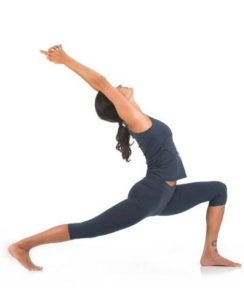
Ankle Weakness and the Healing Power of Yoga
- August 19, 2017

There are many different ways to manage ankle injuries to prevent future issues and help your ankles heal properly. Today we have guest contributor, Dani Stock, telling us how we can use yoga to safely and effectively heal ankle issues such as weakness, stiffness, and instability. Dani is a certified yoga instructor who offers classes in Kitchener/Waterloo. Dani specializes in restorative yoga and yoga practices that work with your lifestyle! She offers regular classes at Flowt KW as well as private and group classes in the comfort of your home, office, or school! Read more about Dani and her yoga classes at: https://www.freeflowyoga.ca/.
Using Yoga Asanas for Building Ankle Stability
Ankle injuries can impede all manner of physical activity, particularly your regular yoga practice. But once the swelling has gone down and the healing process is underway, yoga can be the key to helping your ankle ligaments recover in a safe and effective way.
There are a number of simple yoga poses and modifications that, when practiced regularly over time, can help you build strength and flexibility in an injured ankle. The same applies if you have ankle weakness, either from past injuries that didn’t heal properly or from a natural tendency toward weak ankles.
This article will walk you through a few accessible poses that will help you find greater stability and balance, as well as heal natural issues around the foot, such as fallen arches.
A note on ankle injuries
First things first: if you think you may have sprained or broken your ankle, it’s best to make an appointment with your doctor to diagnose the injury. If you’re diagnosed with a sprain, chances are you will need to take at least two to three weeks off from any physical activity that places a demand on the lower limbs of the body.
An ankle sprain occurs when one or more ligaments in the ankle are stretched beyond their natural capacity. Ligaments serve the purpose of stabilizing bones in that area by preventing them from moving side-to-side. When ligaments are sprained from a fall or twist, you may experience swelling, instability, stiffness, pain, and bruising.
Usually once the swelling and pain have decreased, it becomes safe to return to gentle physical activity, including yoga class. As always, make sure to consult with your doctor about when the time is right to dust off your yoga mat!
Simple yoga modifications for mindful ankle recovery
Before exploring some beneficial poses for ankle healing, anyone practicing yoga with an ankle injury (past or present) should be aware of some simple modifications you can make to your overall practice to ensure a safe experience.
In order to prevent re-injury, yoga practitioners recovering from ankle injuries should take special care to avoid overexerting or overstretching the ankles. This means that in any pose where the ankle goes into plantar extension (pointing the foot) or plantar flexion (flexing the foot), we have to exercise caution. Often this means using a few simple props that you can find around the house.
In balasana, or child’s pose, you’ll want to have a small towel handy to roll up and place under the ankles if you are holding the pose for any length of time. This brings the ankles into a supported natural position.
In adho mukho svanasana, or downward-facing dog, you may want to use a rolled mat or blanket underneath the heels to ground the feet without overstretching the Achilles tendon.
In balancing poses, like vrksasana (tree pose) or garudasana (eagle pose), practice with a wall next to you and don’t be afraid to use one hand on the wall (or your back against the wall) to aid with stability as you work on rebuilding strength and balance.
3 yoga poses to build strength and flexibility around the ankles
1. Tadasana (mountain pose) to talasana (standing on tip toes)
Get into tadasana: stand with your feet hip width apart and the middle toes pointing forward. Lengthening your posture, draw the bellybutton in and let the shoulders relax, bringing the spine into alignment. Feel your weight distributed evenly between the heels and balls of the foot. Draw up through the arches of the feet, pushing firmly into the outer edges. Take a few breaths standing in this alignment. Move into talasana: bring your weight forward into the balls of your feet. On an inhale, lift the heels off the ground holding for the length of the breath, then exhale to release. Repeat ten times. To intensify the effect, raise the arms and heels together, then release the arms and heels together for each repetition.
Helpful hints: Stand with your back supported by a wall if you have trouble with balance in this pose.
Be cautious practicing this pose if you have a headache or low blood pressure. If you have high blood pressure, don’t raise your arms in this pose.

2. Vrksasana (tree pose)
Begin in tadasana (mountain pose) and draw awareness to your feet. Gradually transfer the weight into your right foot, visualizing the sole of the foot rooted into the earth like a tree. Keeping the right leg strong and straight, with the arch lifted and the outer edge of the foot grounding, bend the left knee and place the sole of the foot against the inner right leg, either above the ankle or above the knee, with the toes pointing toward the floor. Create stability here by firmly pushing the sole of the foot against the inner leg, while resisting with the outer right leg. Bring your hands to prayer position over the heart and gaze at a fixed point a few feet in front of you on the floor. Work on opening the left knee out to the side while staying with your balance. Remaining steady, take an inhale to extend the arms toward the sky, reaching the branches of your tree toward the sun. Stay here for five breaths. Softly release out of the position. Take a moment in tadasana before practicing the pose on the other side.
Helpful hints: Stand with your back supported by a wall if you have trouble with balance in this pose.
Be cautious practicing this pose if you have a headache or low blood pressure. If you have high blood pressure, don’t raise your arms in this pose.

3. Anjaneyasana (crescent pose / high lunge)
Beginning in downward-facing dog, exhale and step your right foot forward between your hands, aligning your knee over the heel. Keep your back leg strong and firm, rooting firmly into the ball of the foot. Inhale and raise your torso to upright. Once you’ve found your balance here, sweep your arms forward and raise them overhead, palms facing in. Be careful not to overarch the lower back. Lengthen your tailbone toward the floor and reach back through your left heel. Keep pressing into the ball of the back foot, and rooting firmly through the outside edge of the front foot, lifting gently through the arch and keeping the knee stacked over the ankle. Look up toward your thumbs, without pressing the front ribs forward. Draw them down and into the torso. Hold for ten breaths. Then exhale, release the torso to the right thigh, sweep your hands back onto the floor. On your next exhale, step your right foot back and return to downward-facing dog. Hold for a few breaths and repeat with the left foot forward for the same length of time.
Helpful hints: If you struggle with balance in this pose, begin practicing the pose with the back knee lowered and the top of the back foot grounding.
Be cautious practicing this pose if you have knee pain. If you have neck issues, do not look up between the hands; keep your gaze straight ahead.
Returning to yoga practice after injury can feel daunting, but it doesn’t have to be! Use these safe modifications and gentle ankle strengthening poses to rebuild stability, flexibility, and balance!

Welcome to the East Toronto Foot Care blog!
Here you can learn about foot conditions, our newest services, fun foot facts, and the latest research in foot health!
Search
QUALITY FOOT CARE IN YOUR NEIGHBOURHOOD
FIND US
643 Queen Street East,
Toronto, ON, M4M 1G4
416-792-4420
info@easttorontofootcare.com
HOURS
Sun-Mon: closed
Tues-Wed: 11-7
Thurs-Fri: 12-8
Sat: 10-6
©Copyright 2016-2017 East Toronto Foot Care Inc. All rights reserved.
